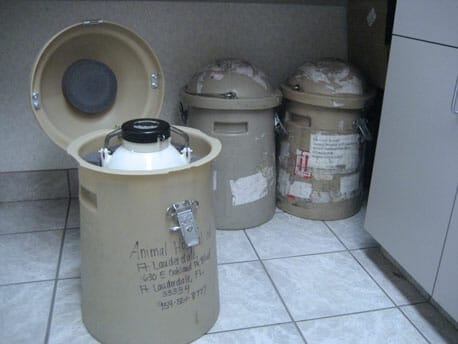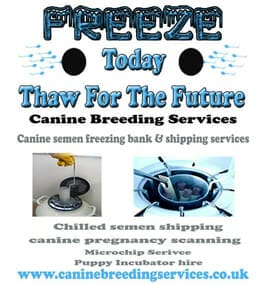Imagine a world where the legacy of your beloved four-legged friend could live on for generations to come. In the fascinating world of canine reproduction, freezing dog sperm has become a key technique for preserving the genetic material of exceptional dogs. But just how long can you keep dog sperm frozen? This article explores the lifespan of frozen dog sperm, shedding light on this intriguing topic and uncovering the possibilities it holds for the future. From the science behind the process to the potential applications, prepare to discover the fascinating world of dog sperm preservation.

Understanding Sperm Freezing
Why freeze canine sperm?
Freezing canine sperm serves a variety of purposes and offers numerous benefits to dog breeders and owners. Some common reasons for freezing dog sperm include preserving the genetics of valuable male dogs, allowing for the possibility of future breeding even if the dog is no longer available for natural mating, and providing a method for artificial insemination. It also enables breeders to transport and share genetic material with other breeders, promoting genetic diversity within the dog population.
Basic process of freezing dog sperm
The process of freezing dog sperm involves several steps to ensure its long-term viability. First, the sperm is collected from the male dog through manual stimulation or the use of an artificial vagina. The collected sample is then evaluated for sperm quality, including factors such as count, motility, and morphology. Next, the sperm is diluted with a special extender solution that protects the cells during the freezing process. Lastly, the diluted sperm is slowly cooled down and transferred into storage vials before being frozen using liquid nitrogen.
Importance of sperm quality before freezing
Before freezing dog sperm, it is crucial to ensure that the sample exhibits optimal quality. Sperm quality serves as a predictor of long-term viability and successful fertilization. Factors such as sperm count, motility, and morphology are all indicators of sperm health. High-quality sperm is more likely to withstand the freezing and thawing process, maintain viability during storage, and have a greater chance of fertilizing an egg. Ensuring the quality of sperm before freezing is therefore essential for achieving successful breeding outcomes.
Duration of Sperm Viability in Liquid Nitrogen
Average duration of sperm longevity
When properly frozen and stored in liquid nitrogen, dog sperm can remain viable for an extended period of time. On average, frozen dog sperm can maintain their viability for up to five to ten years, although individual cases have reported successful inseminations with sperm that has been stored for even longer periods. The longevity of the sperm is dependent on various factors, including the initial sperm quality, the freezing and storage techniques used, and the genetic characteristics of the individual dog.
Factors affecting how long dog sperm can remain frozen
While frozen dog sperm can have remarkable longevity, several factors can affect how long the sperm remains viable. One important factor is the quality of the sperm at the time of freezing. Sperm with higher initial quality is more likely to survive the freezing and thawing process intact and maintain viability during storage. Additionally, the freezing method and storage conditions play a crucial role in preserving the sperm’s longevity. Factors such as temperature fluctuations, exposure to light, and the quality of the storage equipment can impact the viability of frozen sperm.
Reports of longest known frozen dog sperm
The longest known case of successful pregnancy using frozen dog sperm involved sperm that had been stored for an extraordinary 27 years. This exceptional case demonstrates the potential for long-term storage of dog sperm and its viability even after several decades. While this is an outlier, it highlights the resilience of frozen dog sperm when stored under optimal conditions. Such success stories provide hope for breeders and dog owners, emphasizing the importance of proper sperm freezing techniques and appropriate storage methods.
Storage Equipment for Frozen Dog Sperm
Proper storage vials for canine sperm
The selection of appropriate storage vials is crucial for maintaining the quality and viability of frozen dog sperm. It is essential to choose vials made of materials that are compatible with liquid nitrogen and provide a secure seal to prevent contamination or leakage. Traditionally, glass ampules were used for sperm storage, but modern advancements have introduced plastic cryo-vials, which offer improved convenience and safety. These vials are designed to withstand extreme temperatures, ensuring the integrity and longevity of frozen sperm samples.
How long can sperm be stored in specific containers?
The duration of sperm storage can vary depending on the type of container used. Properly sealed and adequately insulated containers, such as liquid nitrogen tanks, can ensure the viability of frozen dog sperm for extended periods. Liquid nitrogen tanks provide a stable and ultra-low temperature environment that can keep the sperm frozen for several years, with reports of successful inseminations even after a decade of storage. However, the quality and integrity of the containers are crucial, as inadequate sealing or insulation can lead to temperature fluctuations and possible damage to the sperm.
Danger of container leakage for sperm viability
Container leakage poses a significant risk to the viability of frozen dog sperm. If the storage vials or containers are not adequately sealed or suffer from leakage, the sperm can come into contact with air or moisture, compromising their viability. Exposure to these external elements can damage the sperm cells or cause ice crystals to form, resulting in reduced fertility potential. Regular inspections and maintenance of storage equipment are essential to prevent container leakage and ensure the preservation of frozen sperm samples.
Health Implications for the Stud Dog
Effects of repeated sperm extractions
The process of collecting sperm from male dogs, whether for fresh use or freezing, can have potential health implications for the stud dog. Repeated extractions of sperm can cause temporary fatigue and stress, but with proper care, these effects are usually short-term. It is important to provide the dog with proper rest and recovery periods between ejaculations to minimize any potential adverse effects. Additionally, a balanced diet, regular exercise, and routine veterinary check-ups are necessary to ensure the overall health and well-being of the stud dog.
Impact of age on viability of frozen sperm
The age of the male dog can influence the viability of frozen sperm. Generally, younger dogs tend to produce higher-quality sperm with better motility and morphology, which enhances the chances of successful freezing and long-term storage. As dogs age, the quality of their sperm may decline, impacting the chances of successful conception with frozen sperm. However, individual variations exist, and proper evaluation of the sperm quality is crucial regardless of the dog’s age. Regular health assessments and monitoring of sperm quality are essential to optimize the freezing process.
Health inspections and their role in sperm collection
Health inspections are a vital aspect of sperm collection from stud dogs. Before collecting sperm for freezing, it is necessary to ensure that the stud dog is in good health and free from any underlying diseases or genetic abnormalities that could be passed on to the offspring. Regular health examinations by a qualified veterinarian can help detect any potential health issues and allow for appropriate management before breeding or semen collection. By prioritizing the health of the stud dog, breeders can increase the chances of successful insemination and contribute to the overall well-being of the dog population.

Influence of the Breed on Frozen Sperm Longevity
Variability in sperm viability across different dog breeds
Sperm viability can vary across different dog breeds, highlighting the influence of breed-specific factors on frozen sperm longevity. Some breeds are naturally predisposed to produce higher-quality sperm, which can enhance the chances of successful freezing and long-term storage. On the other hand, certain breeds may exhibit more challenges in preserving the viability of frozen sperm due to genetic or physiological factors. Understanding these breed-specific variations is essential for breeders to adapt their sperm freezing techniques and storage practices accordingly.
Studies showcasing breed-specific longevity of frozen sperm
Several studies have explored the breed-specific longevity of frozen sperm and observed distinct variations among different dog breeds. For example, research has shown that sperm from certain breeds, such as the German Shepherd, tends to have better longevity and higher post-thaw motility compared to other breeds. Conversely, breeds with lower post-thaw motility, such as the Pekingese, may require specific protocols and careful preservation to maximize the chances of successful insemination. These breed-specific studies allow breeders to tailor their sperm freezing practices to optimize outcomes.
Genetic factors affecting frozen dog sperm
Genetic factors can significantly influence the quality and viability of frozen dog sperm. Inherited traits and genetic variations within a breed can impact the sperm’s ability to withstand the freezing and thawing process and remain viable during storage. Genetic diversity plays a crucial role in maintaining the overall health and vitality of dog populations. Ensuring that genetic factors are taken into consideration during sperm freezing can help preserve desirable traits, minimize the risk of inherited diseases, and contribute to the long-term sustainability of dog breeding programs.
Thawing Process for Frozen Sperm
Steps for thawing frozen dog sperm safely
Thawing frozen dog sperm safely requires a careful and systematic approach to preserve its viability. The thawing process involves several steps, starting with the removal of the frozen vial from storage and quickly transferring it to a thawing water bath set at a specific temperature, usually around 35-37 degrees Celsius. The vial should be gently swirled to ensure uniform warming of the contents. Once thawed, the sperm should be evaluated for quality and motility before proceeding with artificial insemination.
How long does thawed sperm remain viable?
Thawed dog sperm remains viable for a limited period. Generally, the post-thaw lifespan of dog sperm ranges from 24 to 48 hours, although individual variations can occur based on factors such as sperm quality, freezing technique, and storage conditions. It is essential to use the thawed sperm promptly within this viable window to optimize the chances of successful conception. Regular evaluation of post-thaw sperm quality is necessary to maximize breeding outcomes and increase the chances of pregnancy.
Potential risks and solutions during the thawing process
The thawing process for frozen dog sperm carries certain risks that can affect its quality and viability. Rapid or excessive warming can damage the sperm cells or cause thermal shock. It is crucial to carefully monitor and control the water bath temperature during thawing to minimize these risks. Maintaining a consistent and appropriate temperature is essential. Additionally, accidental contamination or mishandling of the thawed sperm can also impact its viability. Strict adherence to proper hygiene practices and the use of sterile equipment are necessary to mitigate these risks and optimize breeding success.

Artificial Insemination Using Frozen Dog Sperm
Timeline for insemination post-thaw
Determining the optimal timeline for artificial insemination using frozen dog sperm is essential to maximize the chances of successful conception. The timing of insemination depends on several factors, including the female dog’s estrus cycle and the quality of the thawed sperm. In most cases, insemination is recommended within a narrow window, typically around 48-72 hours after the female dog’s ovulation. To ensure accurate timing, veterinarians may perform hormonal assays or use other methods to track the female dog’s reproductive cycle and pinpoint the optimal time for insemination.
Success rates of conception with frozen sperm
The success rates of conception using frozen dog sperm can vary depending on various factors. The quality of the thawed sperm, the timing of insemination, and the female dog’s fertility all play significant roles in the outcome. On average, the success rates with frozen dog sperm range from 60% to 80%, although individual variations can occur. Utilizing high-quality sperm, proper timing of insemination, and closely monitoring the female dog’s reproductive cycle can maximize the chances of successful conception and increase the overall breeding success rate.
Post-insemination care for the female dog
After artificial insemination using frozen dog sperm, appropriate post-insemination care is crucial to support the female dog’s reproductive health and increase the chances of successful pregnancy. Rest and reduced physical activity are often recommended to minimize stress on the female dog’s body and support the implantation of fertilized embryos. Additional veterinary care, such as hormonal treatments or progesterone supplementation, may be necessary to optimize the female dog’s reproductive environment. Close monitoring, regular check-ups, and proper nutrition are also important aspects of post-insemination care to promote a healthy pregnancy.
Cost Implications of Freezing Dog Sperm
Average costs for freezing and storing dog sperm
The costs associated with freezing and storing dog sperm can vary depending on several factors, including the geographical location, the specific services offered by the semen storage facility, and any additional services required, such as sperm analysis or health screenings. On average, the cost of freezing and storing dog sperm ranges from $300 to $600, with annual storage fees typically around $100 to $200. It is essential to consider these costs as part of a comprehensive breeding plan and factor them into the overall budget for maintaining a successful breeding program.
Comparative cost of natural breeding vs. artificial insemination with frozen sperm
Comparing the costs of natural breeding versus artificial insemination with frozen dog sperm involves considering various factors. Natural breeding typically incurs minimal direct costs, as it relies on the availability of the male and female dogs and their ability to mate naturally. On the other hand, artificial insemination using frozen sperm involves the costs associated with sperm freezing, storage, and potential veterinary assistance. While the upfront costs of freezing and storing sperm can be significant, artificial insemination allows breeders to access genetic material from valuable male dogs that may not be readily available for natural breeding. The long-term benefits and potential returns on investment must be carefully weighed against the initial costs to determine the most economically feasible option for each breeding scenario.
Availability of sperm freezing services
Sperm freezing services for dogs are increasingly available through specialized reproductive veterinary clinics and semen storage facilities. These services cater to the needs of dog breeders and owners who wish to preserve and utilize the genetic material of their male dogs. It is essential to research and consult with reputable providers to ensure that the necessary expertise and facilities are available to perform the freezing process accurately. Accessibility to sperm freezing services can vary based on geographical location, but with the growing popularity of artificial insemination and the increasing demand for frozen dog sperm, these services are becoming more widely accessible.

Benefits and Possible Risks of Using Frozen Sperm
Benefits to genetic diversity and disease prevention
Using frozen dog sperm offers several benefits related to genetic diversity and disease prevention. By freezing and storing sperm from valuable male dogs, breeders can preserve the genetic traits and characteristics that are desirable within specific breeds. This preservation of genetic diversity helps maintain the overall health and vitality of the dog population, minimizing the risk of inbreeding-related diseases and promoting a wider range of genetic variations. Furthermore, frozen sperm can serve as a valuable resource to introduce and propagate desirable traits across different breeding programs, facilitating the enhancement and preservation of specific breed standards.
Risks associated with the use of frozen sperm
While there are numerous benefits to using frozen dog sperm, certain risks and challenges should be considered. Despite proper freezing and storage techniques, there is always a chance of reduced sperm viability or damage during the freezing and thawing process. Additionally, breeders must take into account the potential limitations of frozen sperm, such as reduced motility or decreased fertility compared to fresh sperm. It is important to work closely with a qualified veterinarian and reproductive specialist to evaluate the quality of frozen sperm and determine the best course of action for breeding success.
Addressing common concerns about using frozen sperm
Using frozen dog sperm may raise common concerns among breeders and dog owners. One frequently raised concern is the potential loss of genetic diversity if too many dogs rely solely on frozen sperm for breeding. However, proper breeding strategies that focus on maintaining diversity within specific breeds can mitigate this concern. Another concern is the need for specialized equipment and expertise to safely handle and thaw frozen sperm. While professional assistance is recommended for optimal outcomes, advancements in reproductive veterinary medicine have made the process more accessible and user-friendly for breeders. By seeking guidance from experienced professionals and staying informed about current practices, breeders can address these concerns and navigate the use of frozen sperm successfully.
Legal Aspects of Dog Sperm Freezing and Use
Ownership rights over frozen dog sperm
The issue of ownership rights over frozen dog sperm can be complex and varies across jurisdictions. It is essential for breeders to familiarize themselves with their local laws and regulations regarding ownership and use of frozen dog sperm. In general, ownership rights over frozen sperm are often linked to the ownership of the stud dog from which the sperm was collected. However, specific contractual agreements between breeders, stud dog owners, and semen storage facilities may need to be established to clarify ownership rights and responsibilities.
Disputes arising from the use of frozen dog sperm
Disputes can arise from the use of frozen dog sperm, particularly in cases where ownership rights or breeding agreements are unclear. These disputes can involve issues such as improper use of the frozen sperm without consent, disagreements over the terms of use, or disagreements regarding the ownership of resulting offspring. To minimize the risk of disputes, clear and legally binding contracts should be established between all parties involved. These agreements should outline the rights and responsibilities of each party, including the use of frozen sperm and any resulting offspring.
Guidelines for ethical collection and use of dog sperm
Guidelines for the ethical collection and use of dog sperm exist to ensure responsible breeding practices and protect the welfare of the animals involved. These guidelines often include recommendations for maintaining the health and well-being of the stud dog, proper handling and storage of frozen sperm, as well as ensuring the safety and ethical treatment of the female dogs during artificial insemination processes. By adhering to these guidelines, breeders can maintain high standards of animal welfare, minimize associated risks, and contribute to the preservation and improvement of dog breeding practices.
In conclusion, understanding the process and implications of freezing dog sperm is crucial for breeders and dog owners seeking to preserve and utilize valuable genetics. From the duration of sperm viability in liquid nitrogen to the influence of breed on frozen sperm longevity, many factors contribute to the success of freezing and using dog sperm for artificial insemination. While there are costs and potential risks involved, the benefits of genetic diversity, disease prevention, and the ability to breed from valuable males make sperm freezing an increasingly popular option in the world of dog breeding. By following best practices, seeking professional guidance, and staying informed about legal aspects and ethical considerations, breeders can make informed decisions and contribute to the long-term sustainability and improvement of dog breeding programs.






Leave a Reply
You must be logged in to post a comment.